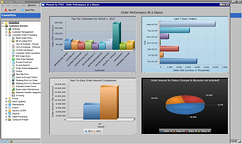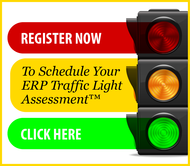Application Modernization
Gasp! Look at that old software! Really?
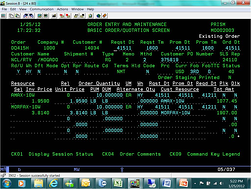 We hear the story all of the time. New executives and managers join a company, see the ERP's text-based green screens and immediately jump to the conclusion that the ERP system is not only old but can't possibly meet the company's current business requirements. Those that merely react and don't examine the facts are effectively "throwing the baby out with the bath water." Those that take the time to carefully analyze the situation quickly realize not only the comprehensive business functionality these legacy applications provide, but that they do satisfy the companies core ERP requirements. Some industry consultants even refer to legacy applications "as those that just work." In fact, most have been enhanced over the years to fit the company evolving requirements like a glove. The information entered into these systems and the enhancements to address changing business requirements is actually an extremely valuable company asset ... intellectual property.
We hear the story all of the time. New executives and managers join a company, see the ERP's text-based green screens and immediately jump to the conclusion that the ERP system is not only old but can't possibly meet the company's current business requirements. Those that merely react and don't examine the facts are effectively "throwing the baby out with the bath water." Those that take the time to carefully analyze the situation quickly realize not only the comprehensive business functionality these legacy applications provide, but that they do satisfy the companies core ERP requirements. Some industry consultants even refer to legacy applications "as those that just work." In fact, most have been enhanced over the years to fit the company evolving requirements like a glove. The information entered into these systems and the enhancements to address changing business requirements is actually an extremely valuable company asset ... intellectual property.
Over the years, more and more valuable intellectual property has been built into these enterprise business applications that you depend on. At the same time, there has been little new development in core ERP system functionality in the marketplace, even with the current Tier 1 suppliers. Too little has been done to core functionality that would justify complete replacement based on new and improved functionality. Replacing an ERP application requires a tremendous amount of resources, costs millions of dollars, and in the end provides similar core functionality as currently available in your legacy ERP application.
Yet, the world and technology are moving at a very fast pace. Many employees entering the workplace today are accustomed to graphical screens on their hand held devices let alone their PCs. In-house applications need to talk with each other and to external systems, exchanging the valuable intellectual property built into them over time. One economically and strategically justifiable answer is to modernize the applications for a very fraction of the cost of replacement and delivering the ease of use and integratability of more modern systems. Modernization provides your organization with an application platform it can use well into the future, while concurrently maintaining a low total cost of ownership.
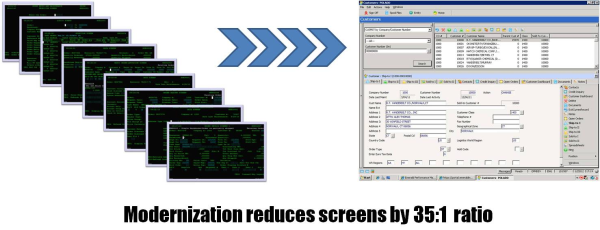
What does application modernization mean?
Application modernization is a broad term covering many different interpretations, methodologies and implementations. The modernization approach you choose depends on your situation which will be driven by factors such as strategic business initiatives, application architecture, time, cost and available skills.
Application modernization means taking an application built in the past and changing it to operate more appropriately for today’s business environment, addressing business opportunities.
Comparing the characteristics of older systems and modern applications provides insight into what will change in the application during the modernization process.
|
Legacy Systems |
Modern Applications |
|
|
|
|
|
|
|
|
|
|
|
|
|
|
|
|
|
Legacy Systems |
|
|
|
|
|
|
|
|
|
Modern Applications |
|
|
|
|
||||
|
|
|
Structured Approach
One of the most important aspects of application modernization is the ability to retain all of the intellectual property built into the applications over the years you've used them. At the same time, modernization provides an environment that can grow on employing the modern application architecture modernization puts in place.
Our Application Modernization Roadmap
Application modernization is best accomplished with a tested roadmap for the project, such as that provided by PSGi. PSGi uses the native IBM modernization tools available on the IBM i along with tools from our partner, Lansa, to bring the most comprehensive set of modernization solutions possible to our customers.
- Application Assessment – The most effective modernization projects do not focus on entire applications but those areas where there is currently the most risk of issues and the most opportunity for improvement.
- Modernization Options – There are a variety of tools and methods available to modernize the application. The objective can be as simple as providing a new user interface over the web or as complicated as complete architecture replacement. The correct answer for a situation is usually in the middle of these extremes. It is important to match the solution to the problem using the most effective modernization tools available.
- Design and Planning - Identify options for application modernization based on a detailed analysis and discovery of the application software and how it is used in your business environment.
- Implementation – Develop the solution identified using the desired tool and strategies to most effectively bring the solution to your users.
Flexible options to meet your application modernization needs
The modernization process retains the existing application and allows you to move components of the application into new environments, such as web-enabling the user interface or opening up parts of the application as a web service. A benefit of application modernization is keeping what is already in place, including the intellectual property. Your organization already knows how the existing application works and it already supports your specific business requirements. Modernization will improve the ROI on the ongoing investment being made in the application.
Using IBM tools and LANSA's application modernization products, PSGi can work with your team to modernize as much or as little of your legacy application as desired.
Replace Specific Functionality
Replace does not mean to replace an entire application, but rather to make available new applications that can replace current functionality. As an example, a user may have an inquiry to look at data which might bebetter viewed as a charts or a graph. Then a modernization task, a rich graphical-based application, can replace the inquiry and the user could still optionally drill down further into the data he would have seen originally.
Improved Workflow
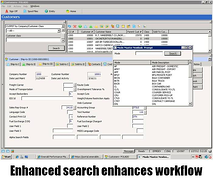 Older applications are built with rigid workflow mirroring business processes that may be extinct and no longer represent the desired or current way of doing business. It is quite common for users to be frustrated with this rigidity and use external "systems" like notepads or spreadsheets to complete the task at hand. This leads to inaccuracies, inefficiencies and lost information which may be intellectual property. Modernizations provides the ability to enhance the workflow while not impacting the underlying functionality of the applications, i.e. it doesn't "know" the user is not hitting the keys. A few ways modernization can enhance workflow include:
Older applications are built with rigid workflow mirroring business processes that may be extinct and no longer represent the desired or current way of doing business. It is quite common for users to be frustrated with this rigidity and use external "systems" like notepads or spreadsheets to complete the task at hand. This leads to inaccuracies, inefficiencies and lost information which may be intellectual property. Modernizations provides the ability to enhance the workflow while not impacting the underlying functionality of the applications, i.e. it doesn't "know" the user is not hitting the keys. A few ways modernization can enhance workflow include:
- Navigation via point and click within the tree-like structure of the application allows the user direct access to the function without navigating through multiple screens
- Enhanced query capability that is not present in original application quickly provides access to summary information for user to select desired items
- Information from different parts of the application can be brought to a single screen instead of requiring the user to bounce around the application to collect the information manually
- Fields modern graphical objects, such as tabbed cabinets, allow user to be directed to specific areas of the application, other internal applications or even areas external to the organization such as websites.
Improved Deployment
Getting access to your applications via a browser or just an improved user interface is the most basic step in modernizing your applications. PSGi's expertise and tools can help achieve deployment goals quickly and efficiently.
Modernization Provides
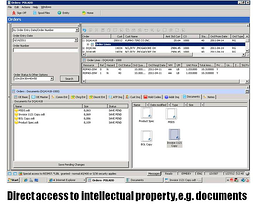 Most modernization projects involve not only improving the user interface and deployment options, but maintaining all of your intellectual property built into your applications while:
Most modernization projects involve not only improving the user interface and deployment options, but maintaining all of your intellectual property built into your applications while:
- Providing faster access to decision data
- Providing a single interface to disparate systems
- Providing seamless integration between systems
- Providing an integration layer to older applications which can then be accessed through modern technologies
- Providing a framework that can be applied across existing applications allowing future growth and ease of deployment of any application in your environment.
- Providing a framework for development of new modules of functionality to address new business requirements
Modernization Summarized
Organizations have made significant investments over the years in their current enterprise business applications. Most of these applications continue providing a substantial return on this continuing investment. While these investments are partially used to maintain these systems, a portion of the investment has been employed creating a wealth of company-specific intellectual property - a valuable company asset. Modernizing functionally rich legacy ERP applications that "just work" is a cost-effective means of providing a contemporary graphical user interface, enhanced business workflow and simplified means of integrating systems on a broad scale. All of this while maintaining the intellectual property asset. And all of this at a fraction of the cost and pain of replacing these applications with applications of equal core ERP functionality.

